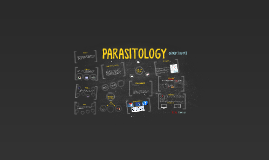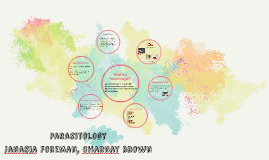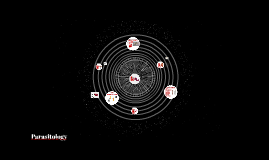Parasitology
Transcript: Diseases Caused by Parasites A parasite is an organism that spend most of its life feeding of another organism. What's very interesting about this monsters is that they are incredibly adaptable to any change. It's no wonder parasites extremely outnumber us. The study of parasites In one branch of biology or medicine concerned with the study of parasitic organisms is called Parasitology. In other words, the study of parasites, their hosts, and the relationship between them. Malaria Malaria is the most common heard parasitic disease which kills hundreds of millions of people in third world countries. Originating from Africa, spreading into South America where many people got infected during the construction of the Panama Canal. How to prevent parasidiocal diseases - Vaccines - Personal Hygiene - Anti-biotics - Avoid obviously contaminated areas Treatment The two main treatments are surgery and medicines Filarial Worms Filarial worms, which are found primarily in tropical regions of Asia, are threadlike worms that live in the blood and lymph vessels of birds and mammals such as humans. They are transmitted from one primary host to another through biting insects, especially mosquitoes. In severe infections, large numbers of filarial worms may block the passage of fluids within the lymph vessels. This causes elephantiasis, a condition in which an affected part of the body swells enormously. Fortunately, extreme cases of elephantiasis are now rare. Eye Worms Eye worms are closely related to the filarial worms that cause elephantiasis. They are found in Africa and affect both humans and baboons. Eye worms live in and burrow through the tissues just below the skin of their host. In their travels, the worms occasionally move across the surface of the eye- hence the name eye worm. Tapeworms Members of the class Cestoda are long, flat, parasitic worms that live a very simple life. (They have a head called a scolex (SKOH-leks) on which there are several suckers and a ring of hooks. These structures attach to the intestinal walls of humans and other animals. Inside the intestine, these worms are surrounded with food that their primary host has already digested for them. The worms absorb this food through their body walls, allowing them to grow to impressive sizes- adult human tapeworms have been seen over 18 meters long! Tapeworms almost never kill their hosts, but they do use up a lot of food. For this reason, hosts may lose weight and become weak. Behind the scolex of the tapeworm is a narrow neck region that is contstantly dividing to form the many proglottids (proh-GLAH-tihds), or sections, that make up most of the body of the tapeworm. Proglottids contain little more than male and female reproductive organs. Sperm produced by the testes, or male reproductive organs, can fertilize eggs in the proglottids of other tapeworms or of the same individual. Fertilized tapeworm eggs are released when mature proglottides break off the posterior end of the tapeworm and burst open. A mature proglottide may rupture either in the host's intestine or after it has been passed out of the host's body with feces. A single proglottide may contain over 100,000 eggs, and a single worm can produce more than half a billion eggs each year! If food or water contaminated with tapeworm eggs is consumed by cows, pigs, fishes, or other intermediate hosts, the eggs enter the intermediate host and they hatch into larvae. These larvae grow for a time and then burrow into the muscle tissue of the intermediate host and form a dormant protective stage called a cyst. If a human eats raw or incompletely cooked meat containing these cysts, the larvae become active within the human host. Once inside the intestine of the new host, they latch onto the intestinal wall and grow into adult worms. Parasitic Flatworms Parasitic flatworms feed on blood, tissue fluids, or pieces of cells inside the bodies of their hosts. Some of these animals have a pharynx that pumps food into a pair of dead-end intestinal sacs where the food is digested, but in many parasitic flatworms the digestive tract is simpler than in free-living forms. For example, tapeworms, a common type of parasitic flatworm, has no digestive tract at all instead, they live inside the intestines of their hosts and feed by latching onto the intestinal wall with hooks and/or suckers and absorbing the food that passes by- food that has already been broken down by the host's digestive enzymes. Flatworms lack any kind of specialized circulatory or respiratory system. Because they are so flat, they can depend on diffusion to transport oxygen and nutrients to their tissues. And they can get rid of carbon dioxide and most other metabolic wastes by allowing them to diffuse out through their body walls. Parasitic flatworms also often do not have much of a nervous system. As you can imagine, there is not much need for a nervous system in an organism that mainly hangs onto an intestinal wall and absorbs food! In

















